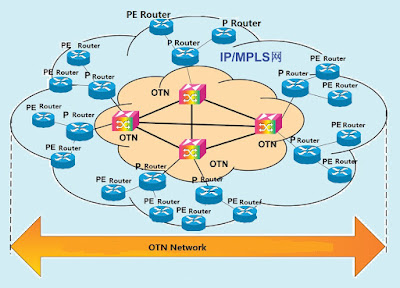Optical transport network for IP services, IP transport requirements adaptation service has become an important issue in the further development of optical communication. Optical transport network from a variety of angles and provide a solution compatible with the existing technology in the premise, because the large number of applications SDH equipment, in order to solve the processing and transmission of data services, based on SDH technology developed MSTP equipment and has a large number of applications in the network, it is well compatible with existing technology, but also to meet the transfer function data services. But with the increasing processing power and requires more detailed data services particles, business demand for transport network presented two aspects: on the one hand the transmission network to provide a large pipeline, then generalized OTN technology (in the electric field is OTH, in the optical domain ROADM) provides a new solution that solves the SDH-based cross particles VC-12 / VC4 is small, scheduling more complex issues not meet service delivery needs of large particles, in part, to overcome the WDM System fault location difficult to point to point connection-oriented networking, network capacity is weak, network survivability and ability to provide a means shortcomings weak; on the other hand service optical transport network to propose a more detailed processing requirements, the industry also made a packet transport network solution, the main technologies involved include T-MPLS and PBB-TE and the like.
Digital transmission network evolution from the original based T1 / E1 of the first generation of digital transmission network, experienced-based SONET / SDH second generation digital transmission network, to the development in the third generation of OTN-based digital transmission network. First and second generation transport network was originally designed for voice services specifically designed, though can also be used to transmit data and video services, but the transmission efficiency is not high. In contrast, the third-generation transport network technology, from the design to support voice, data and video services to support the bandwidth on demand (BOD) when with other protocols, quality cut of service (QoS) and optical virtual private net (OVPN) and other functions.
In 1998, the ITU Telecommunication Standardization Sector (ITU-T) formally proposed the concept of OTN. From the functional point of view, OTN can be transmitted in the form of all-optical subnet, and the use of light at the boundary of sub - electricity - light conversion. Thus, each subnet can 3R regenerator coupled to constitute a large optical network, as shown in FIG. Therefore, OTN transport network can be seen as the all-optical network evolution process of a transition application.
In the OTN functional description, the optical signal is wavelength (or center wavelength) to characterize. Optical signal processing may be based on a single wavelength, or based on a WDM group. (Based on other optical multiplexing, time division multiplexing, optical time division multiplexing, or optical code division multiplexing OTN, remains to be studied.) OTN can be achieved in the optical domain transfer service signals, multiplexing, routing, monitoring, and to ensure its performance and survivability. OTN can support a variety of top business or protocols, such as SONE / SDH, ATM, Ethernet, IP, PDH, Fibre Channel, GFP, MPLS, OTN virtual concatenation, ODU multiplexing, is the ideal foundation for future network evolution. More and more operators worldwide start constructing a new generation of OTN-based transport networks, systems manufacturers have also introduced a more OTN features of the product to support building the next generation transport network.



No comments:
Post a Comment